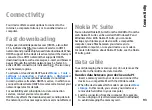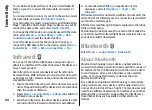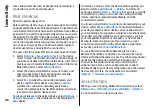
Java security settings
To specify security settings for a Java application, select
Options
>
Settings
.
You can define which functions the Java application can
access. The value that you can set for each functionality
depends on the protection domain of the software
package.
•
Access point
— Select an access point that the
application may use when making network
connections.
•
Network access
— Allow the application to create a
data connection to the network.
•
Messaging
— Allow the application to send messages.
•
Application auto-start
— Allow the application to
start automatically.
•
Connectivity
— Allow the application to activate a data
connection, such as a Bluetooth connection.
•
Multimedia
— Allow the application to use the
multimedia features of your device.
•
Read user data
— Allow the application to read your
calendar entries, contacts, or any other personal data.
•
Edit user data
— Allow the application to add personal
data, such as entries to Contacts.
•
Positioning
— Allow the application to use the
location data in your device.
•
Landmarks
— Allow the application to use the
landmarks in your device.
You can define how you are prompted to confirm the Java
application's access to the device functions. Select one of
the following values:
•
Ask every time
— Require the Java application to ask
for your confirmation each time it uses the
functionality.
•
Ask first time
— Require the Java application to ask for
initial confirmation to use the functionality.
•
Always allowed
— Allow the Java application to use
the functionality without your confirmation. The
security settings help protect your device against
harmful Java applications that may use the functions of
your device without your permission. Only select
Always allowed
if you know the supplier and
trustworthiness of the application.
•
Not allowed
— Prevent the Java application from
using the functionality.
Activation keys
Select
Menu
>
Tools
>
Actv. keys
.
Some media files, such as images, music, or video clips, are
protected by digital usage rights. The activation keys for
such files may allow or restrict their usage. For example,
with some activation keys you may listen to a music track
only a limited number of times. During one playback
session you may rewind, fast-forward, or pause the track,
but once you stop it, you have used one of the instances
allowed.
Use activation keys
Digital rights management (DRM) protected content
comes with an associated activation key that defines your
rights to use the content.
107
Sec
urity an
d data
m
ana
gem
ent






























